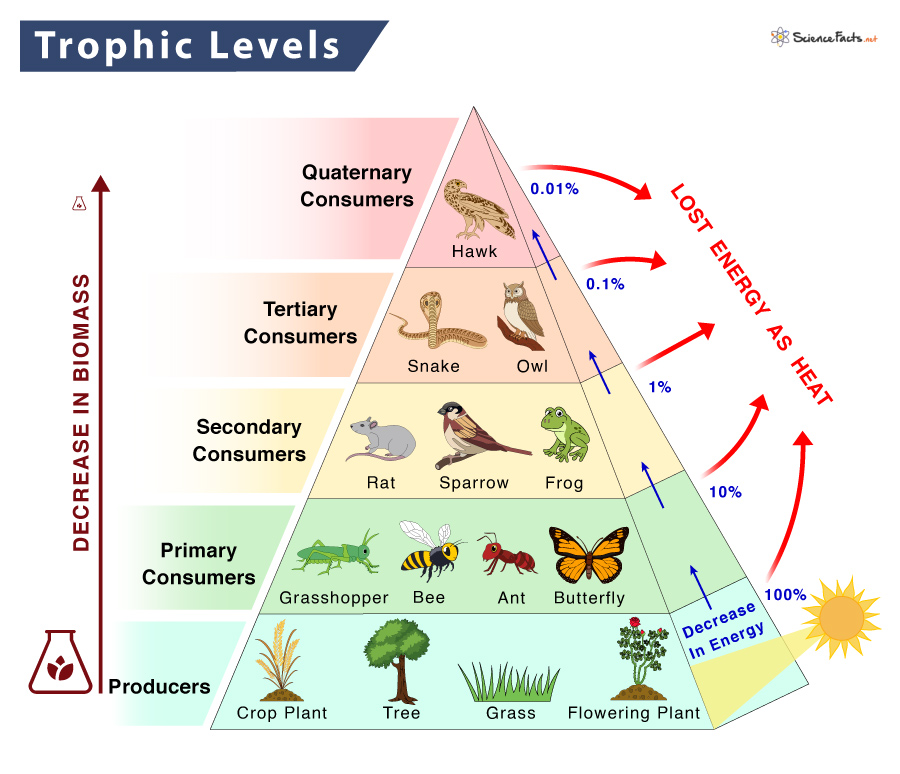Which Shows the Correct Order of Increasing Trophic Level, from Producer to Tertiary Consumer? Unveiling the Trophic Hierarchy
Within ecosystems, organisms are interconnected through a food web, where energy is transferred from one trophic level to another. Trophic levels represent different levels of the food chain, ranging from primary producers to consumers. Understanding the correct order of increasing trophic level is crucial to comprehend the flow of energy and nutrients within an ecosystem. In this article, we will explore the trophic hierarchy and unveil the correct sequence from producer to tertiary consumer. So, let's embark on this educational journey and shed light on the fascinating world of trophic interactions.
1. Definition of Trophic Levels

Trophic Levels
Trophic levels represent the position of organisms within a food chain or food web based on their source of energy and their role as producers or consumers.
The primary producers, or autotrophs, occupy the first trophic level, while subsequent levels are occupied by different types of consumers.
2. Primary Producers: The Foundation of the Food Chain
Primary producers, typically green plants and algae, occupy the first trophic level. These organisms are capable of converting sunlight, water, and carbon dioxide into energy through photosynthesis.
They form the basis of the food chain by producing organic matter that fuels subsequent trophic levels.
3. Primary Consumers: The Herbivores

The Herbivores
Primary consumers, also known as herbivores, are organisms that directly consume primary producers.
They occupy the second trophic level. Herbivores extract energy and nutrients by feeding on plants or algae.
Examples of primary consumers include deer, rabbits, and insects.
4. Secondary Consumers: The Carnivores
Secondary consumers occupy the third trophic level and are known as carnivores. These organisms prey on other consumers for their energy and nutrients.
They derive their sustenance by consuming primary consumers or other secondary consumers. Examples of secondary consumers include snakes, wolves, and larger fish.
5. Tertiary Consumers: The Top Predators
Tertiary consumers, also referred to as top predators, occupy the fourth trophic level. These organisms feed on both secondary consumers and, in some cases, primary consumers.
Tertiary consumers play a crucial role in regulating population sizes and maintaining ecosystem balance. Examples of tertiary consumers include large predators like lions, sharks, and eagles.
6. Decomposers: Nature's Recyclers
While not considered part of the traditional trophic levels, decomposers play a vital role in nutrient cycling within ecosystems.
Decomposers, such as bacteria and fungi, break down organic matter from dead organisms, releasing nutrients back into the soil or water. They facilitate the recycling of nutrients, making them available for primary producers once again.
7. Correct Order of Increasing Trophic Level
Based on the trophic hierarchy described above, the correct order of increasing trophic level, from producer to tertiary consumer, is as follows:
Primary Producers (Autotrophs) → Primary Consumers (Herbivores) → Secondary Consumers (Carnivores) → Tertiary Consumers (Top Predators)
It is important to note that while this is the general sequence, variations can exist within different ecosystems depending on the specific organisms and interactions present.
In conclusion, understanding the correct order of increasing trophic level is essential for comprehending the flow of energy and nutrients within an ecosystem. Primary producers form the foundation of the food chain, followed by primary consumers, secondary consumers, and finally, tertiary consumers. This trophic hierarchy represents the transfer of energy and nutrients from one organism to another, sustaining life and maintaining ecosystem balance. By unraveling the complexities of trophic interactions, we gain valuable insights into the interconnectedness of organisms and the delicate web of life. So, let us continue to explore and appreciate the fascinating world of trophic levels and their significance in shaping our natural environment.